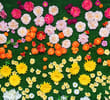Pollination and Types of Pollination
We are surrounded by nature that is blooming with flowers. Beautiful flowers are not just attracting to the human eye, but the senses of the bees and other living creatures. If you have a garden or you take a stroll in nature's lap, then your vision must have caught a beautiful sight of bees humming over flowers. And, most often or not, you must have wondered why?
Reproduction is a life process. All living organisms, including the flowers reproduce. Pollination is the term for flower reproduction.

What is Flower Pollination?
The transfer of pollen from a male part of the plant to the female part of the plant--stigma, later enabling fertilization and the production of seeds is known as pollination. As flowers are stationary, Pollinating agents or pollinators like bees, insects, bats, water or wind carry out the process of transferring pollen from male flower to female flower. Hence, bees and other animals are often seen around the flowers.
Agents of Pollination
Pollination process occurs in two forms, abiotic or biotic. Abiotic pollination happens due to non-living organisms, whereas the biotic pollination is carried out by living organisms.
● Insect Pollination: Bees are the most common and recognized insect pollination. Flowers contain nectar, a staple bee diet. The pollination by bees, butterflies, moths, flies is known as hymenopterophily. Pollination by ants is known as myrmecophily.
● Bird Pollination: Some birds, especially hummingbirds pollinate plants. Birds are usually attracted to bright colours, like red and yellow colour flowers. Flowers that are pollinated by birds are long-tubular with nectar, and are sturdy enough for perching on.
● Animal Pollination: Bats are nocturnal pollinators, meaning active at night. The flowers that attract bats need to have a strong fragrance and may not be colourful.
● Wind and Water Pollination: Wind pollinates many plants. Flowers that have long stamens and pistils are pollinated by the wind. Pollens carried by the wind are lighter in the pollens carried by the animals. Plants and flowers that thrive in water are pollinated by water.
“BEE MEET THE FLOWER IS NOT THE ONLY WAY TO POLLINATE, THERE ARE OTHER TYPES OF POLLINATION.”
1. Self-Pollination
It is a kind of basic pollination. In self-pollination, the pollen grains from the anther of a flower is transferred to the stigma of the same flower. This self-pollination process is known as Autogamy. Two conditions are necessary for the autogamy to take place:
●Anther-stigma synchronization when the pollens are released
●The anther and stigma of the flower should be positioned or at a close distance.
When the transfer of the pollen grains happens between the anther and stigma of the different flowers of the same plant, it is Geitonogamy.
2. Cross Pollination
In this type of pollination, the pollen from the anther of the flower on one plant is transferred to the stigma of the flower on another plant of the same species. For the cross-pollination to occur, flowers of the same plant species are required. Pollinators successfully carry out the cross-pollination between flowers.
3. Hand Pollination
The other name of this type of pollination is mechanical pollination. It is done when self pollination and cross pollination are undesirable. In this, pollen grains are manually transferred from the stamen of one flower to the pistil of the other. Cotton swabs or brush are the tools put into use for pollen transfer.
Now go out and witness pollination in action!















